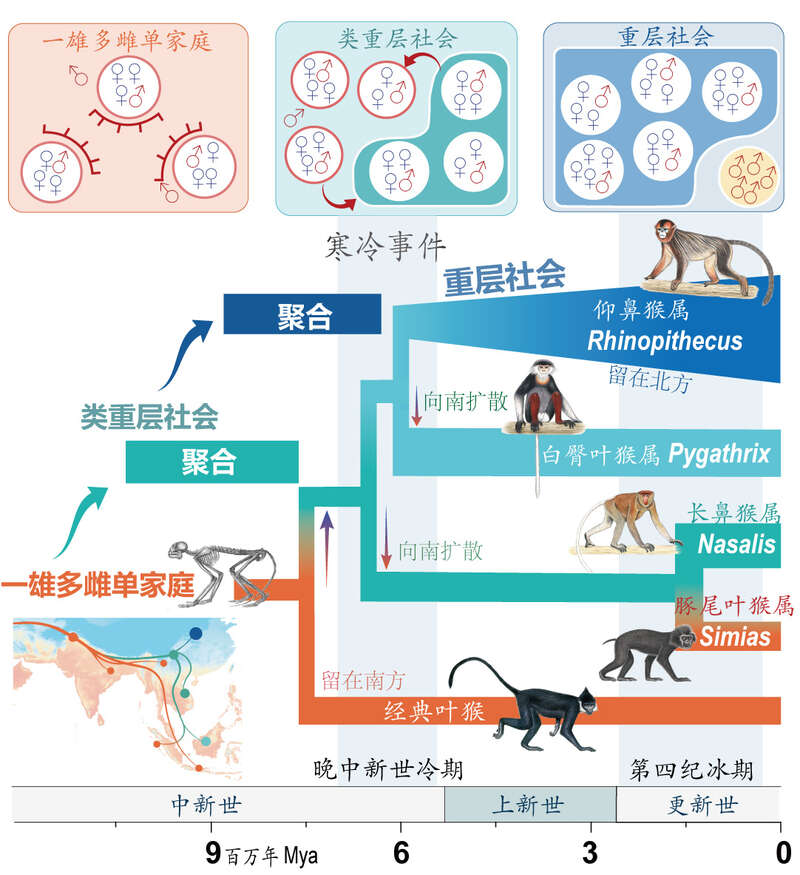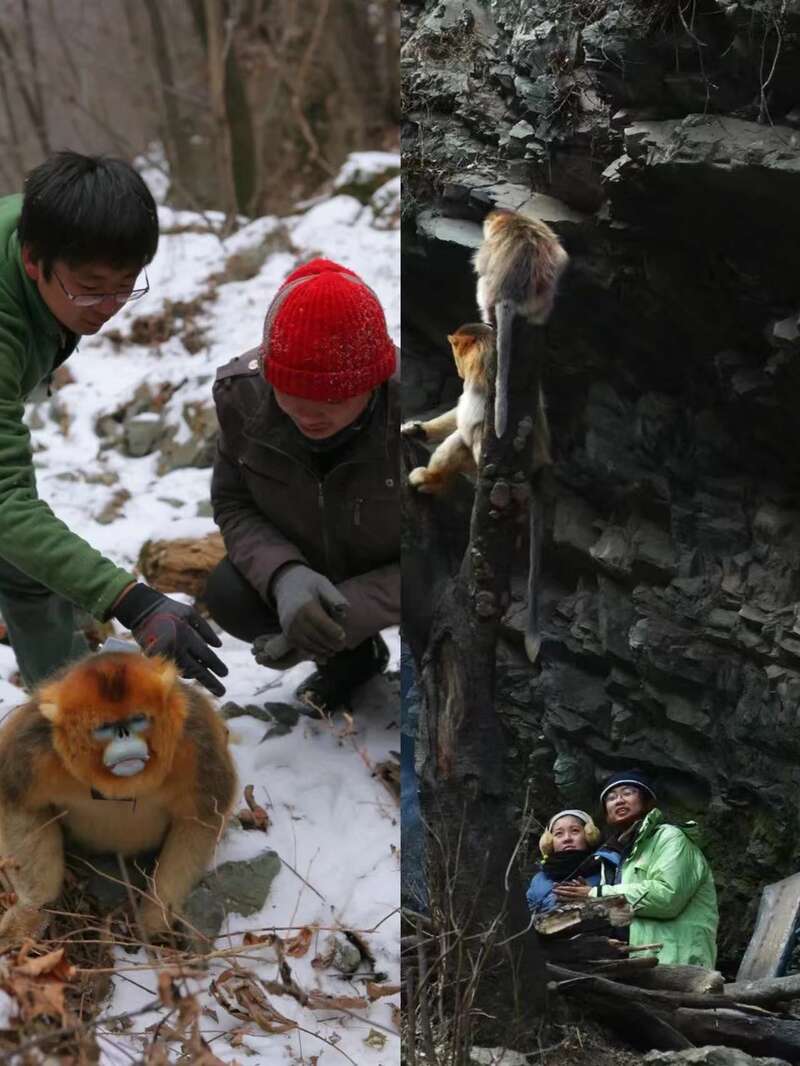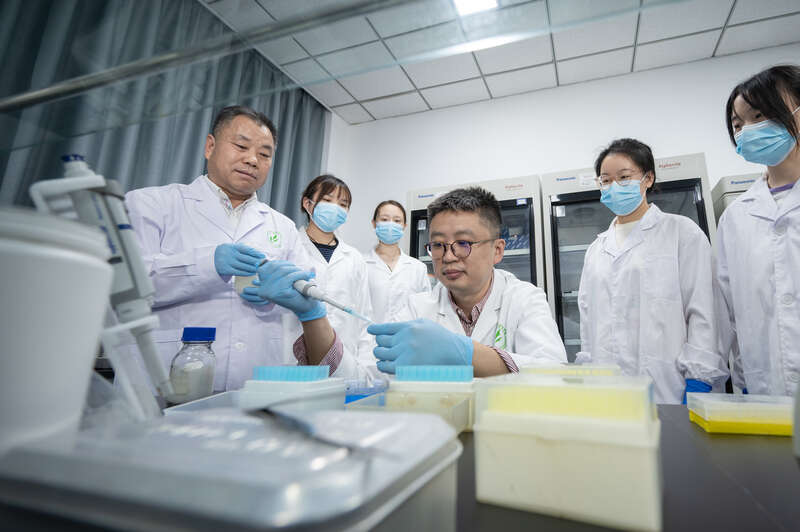Golden monkey on the cover of Science
Zhu Yue Wei Mengge Zhongqing Bao Zhongqing Net reporter Sun Haihua
From the orangutans who like to live alone, to the gibbons with white palms, to the langurs with harem, and the cynomolgus monkeys who marry in groups, the primates’ views on marriage and love and the size of their social circle are very different. What kind of driving force has shaped this difference? This question was answered in the study of Asian langur by the team of Northwest University-
In the early morning of June 2nd, Science magazine published the latest research achievement Adaptations to a cold climate promoted social evolution in Asian colobine primates in the form of a long article, which systematically revealed the mystery of primate social evolution for the first time. The cover picture of this issue of Science shows the representative of Asian langur-Qinling golden monkey, and the picture is provided by the research team of Northwest University.

Restore the evolution history of Asian langur social system
"Primates have a complex and diverse social structure. Their social structure has a strong phylogenetic signal, and it has been deeply influenced by historical environmental upheaval and recorded in their genomes. " Qi Xiaoguang, a professor at the School of Life Sciences of Northwest University and co-first author of the paper, said at the press conference on related research results held by Northwest University on June 2.
"We have been focusing on the study of golden monkeys for more than 20 years, using the method of combining GPS collar, satellite remote sensing technology and social network analysis, and through long-term field tracking and observation, we have always wanted to uncover the mystery of primate society." Li Baoguo, a professor at Northwest University and co-correspondent, introduced.
After years of research, the team found that the golden monkey society has a unique four-layer social structure: family, detachment, group and community. In 2014, Qi Xiaoguang and Li Baoguo jointly developed a paper in the journal Nature-Communication, and put forward the hypothesis of "Asian origin-aggregation" for the first time, which broke the single understanding of the complex social origin of primates by western scholars and opened a new avenue for studying the evolution of animal social systems.
This time, the research team extended their eyes to 8 million years ago, and pieced together the diffusion path of Asian langur ancestors from the historical distribution suggested by biological fossils and the excavation of big data such as ancient sea level, ancient geography and ancient climate.
About 8 million years ago in Miocene, the ancestors of Asian langurs spread from Europe.
One of them spread from the Indian Peninsula to Southeast Asia, and this group divided into three genera, and retained the ancestral "single family group" social system of one male and many females.
The other branch spread to Yunnan, China in the late Miocene, and formed the base group of strange-nosed monkeys. With the cold events in the late Miocene in this area, their family groups were no longer mutually exclusive, and sometimes separated and sometimes aggregated, forming a heavy-class society.
Due to the lack of food, most of the strange-nosed monkeys later spread to the south and evolved into different species such as white-rumped langurs and proboscis monkeys. Today, although they live in warm areas of Viet Nam and kalimantan island, they still retain the structural feature of a class-heavy society.
At the same time, the golden monkey, a close relative who stayed in the north of China, drew closer social relations, cultivated long-term and stable ties between families, and evolved a real stratified society in the repeated glacial and interglacial cold events in the Pleistocene.

"We found that species living in cold environments tend to form larger communities, and two social aggregations occurred in the Late Miocene Cold Period and the Pleistocene Quaternary Ice Age, respectively, which indicates that cold events may have driven community aggregation." Qi Xiaoguang said that on this basis, the team put forward the social evolution history of the Asian langur "three acts". This discovery is also a systematic exposition of the hypothesis of "Asian origin-aggregation" put forward by the team.

Why did you choose the Asian langur as the research object? Scientists have also given the best answer: Asian langur belongs to the Old World Macaca colobus subfamily, with a total of 55 species in seven genera, including four different social system types: monogamous society, polygamous society, stratified society and quasi-stratified society, which are distributed from tropical rain forest to temperate snow-capped mountains. The team believes that this group is a good model for studying the social evolution mechanism system of primates.
In order to do this research well, the team cooperated with universities, research institutes, zoos and other teams at home and abroad to analyze and investigate 2903 habitats of Asian langur, and analyzed the comprehensive ecological factors of 19 environmental variables extracted from each habitat, thus constructing the most comprehensive Asian ecological data set so far.
Establish a research framework of "behavior-ecology-genome"
In the long history of 8 million years, how did the repeated cold events drive the Asian langur to complete the community gathering? This needs to be confirmed by analyzing the genome data passed down from generation to generation.
In order to answer the questions, the team creatively established a brand-new research paradigm of "behavior-ecology-genome". They overcame many difficulties such as cross-discipline and cross-region, completed high-quality genome sequencing of seven representative species of Asian langur, and obtained the world’s first non-human primate genome at chromosome level, thus constructing accurate phylogenetic relationships.

"We combine the central principles of macroevolution’s biology and micro-molecular biology to explore the genetic mechanism behind the cold events driving community aggregation." Qi Xiaoguang said. Through comparative genomics and phylogenetic analysis, it is shown that the cold events in history have promoted the positive selection of energy metabolism and neurohormonal regulation-related genes in Asian langur, and evolved a more effective brain, neurohormonal regulation network. Among them, the gene changes related to oxytocin and dopamine transmitter system in the strange-nosed monkey group are particularly striking: the society of its group presents a two-step step polymerization model, from "polygamy" of its ancestors to the formation of separation.
The team found that in mammals, oxytocin and dopamine can strengthen the bond between mother and child. The cold effect triggered their adaptive changes, strengthened the bond between mother and baby, and prolonged the parental rearing of the strange-nosed monkeys in cold areas. At the same time, the friendly behavior between individuals has also been promoted, which has further promoted the gathering of single family groups to a heavy society. This result has also been verified by cell function experiments and behavioral experiments.

"For example, our Qinling golden monkeys, where the climate is cold and food is scarce, will have more behaviors of holding groups to keep warm and grooming each other. Such a neuromodulation mechanism also indirectly increases the individual’s friendly behavior and tolerance, thus promoting the gathering of family groups to a heavy society. " Qi Xiaoguang said.
This study integrates animal behavior, ecology, geology, comparative genomics and other multidisciplinary means, and completely reveals the evolution process, motivation and genetic basis of the complex social system of Asian langur. Its greater significance lies in the establishment of a new research paradigm of "behavior-ecology-genome", which provides a new way to understand the origin and evolution mechanism of primate social behavior, including human beings, and also opens up a new direction for the development of animal behavior.
As the reviewer of Science magazine commented: "The author has traced back the social evolution history of Asian langur completely through multidisciplinary methods, and comprehensively analyzed its ecological causes and genetic basis, which is unprecedented in the study of primates and vertebrates, and has opened up a new avenue for the field of social evolution."
Stick to the original heart: "If you like it, you want to protect it."
It is Qi Xiaoguang’s greatest wish for many years to make such a beautiful Qinling golden monkey on the cover of Science for the whole world to see. In 1999, he joined the golden monkey research team of Northwest University, studied under Professor Li Baoguo, and became one of the pioneers in the field research of Qinling Golden Monkey.
"The first time I saw the golden monkey was during the winter vacation of my freshman year." After walking alone for 12 hours, Qi Xiaoguang finally saw them in the depths of the Qinling Mountains: "Wow, they jumped over my head-light yellow hair, light blue skin, pure eyes … so beautiful!" "If you like it, you want to protect it" has become his initial intention to study the golden monkey for more than 20 years.
In his early years, Qi Xiaoguang spent six or seven months every year in the Qinling Golden Monkey Base, crossing the mountains and sleeping around the clock, carefully observing every subtle movement of the Golden Monkey, and spared no effort to collect data and analyze the research results. It is also because they are stationed in the field base all the year round that they explore a set of methods suitable for the study of mountain primate behavior, which lays a key foundation for the follow-up research.
"In the past, the research on the evolution mechanism of primate social systems has always stayed at a purely macro level, lacking in-depth exploration of molecular mechanisms. It is precisely because of the lack of suitable research templates and genome-wide data that there has been no major breakthrough in its specific evolutionary mechanism, especially its genetic basis. " After consulting a number of experts in the animal field, Qi Xiaoguang and team experts began a lonely attempt. Trying to try and make mistakes again and again, overthrowing and reorganizing again and again … It was this time that led Wu Jinwei and Zhao Lan to explore together, which made Qi Xiaoguang unforgettable.

Finally, the team finally found a clue to break through the bottleneck in micro-molecular biology. In the face of an extremely huge, complicated and completely unfamiliar new field, the team is quietly making breakthroughs. "The artificial classification of disciplines makes us only see one side, but biological evolution itself will not be inevitable because of these artificial classifications, which also forces us to look at the process and practice of evolution with a comprehensive eye." Zhao Lan said.
On the campus of Northwest University, Qi Xiaoguang often communicates with the teachers and students of the team of Shu Degan academicians who studied CAMBRIAN fossils 500 million years ago. Although their research period spans hundreds of millions of years, it involves many dimensions, such as behavior, ecology, geology, fossils and heredity. As long as there is an intersection, he will be interested.
"In the future, we will continue to deepen the research on the evolution mechanism of primate social systems represented by Asian langurs, and then explore the origin and changes of early human society." Qi Xiaoguang is full of expectations.